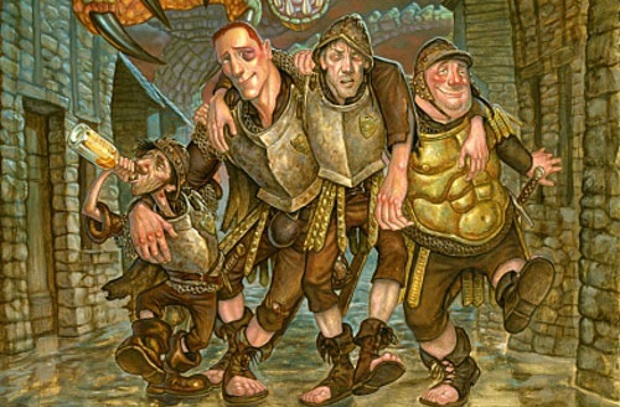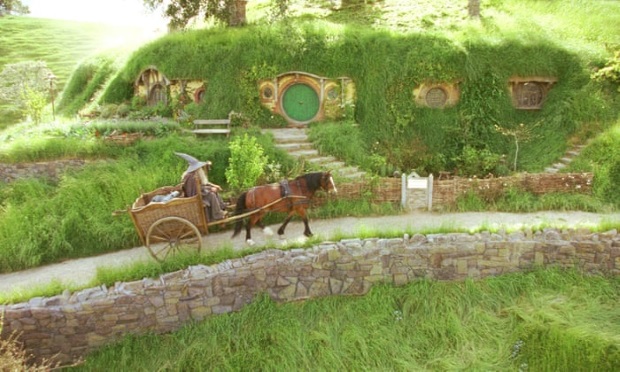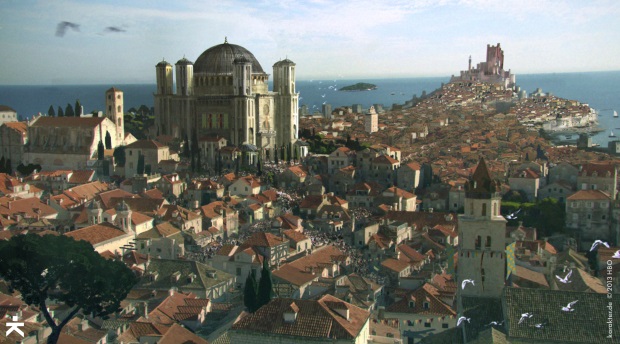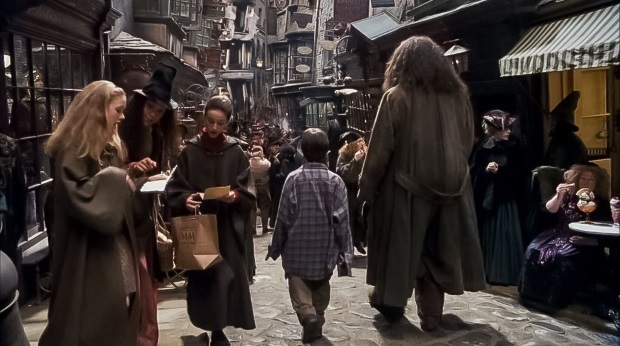Approaches to Worldbuilding in Fantasy
Characters, history, sewage - there's a lot to consider when creating a brand new world.
This article comes from Den of Geek UK.
Tolkien took twelve years, J.K. Rowling seventeen. Terry Pratchett started the Discworld novels in 1983, and they finished thirty-two years later. George R. R. Martin started A Song Of Ice And Fire in 1991 and it remains unfinished. God managed to build the world in six days, though to be fair he didn’t really do much plotting.
In this article we’re going to look at the worldbuilding in the examples mentioned above; some of the most famous and popular fantasy series in the world, but still barely scratching the surface of the genre and leaning towards High Fantasy (broadly speaking, High Fantasy tends towards the epic and takes places in a fictional universe, with Low Fantasy taking place in the real world or a world very like ours but with fantastical elements).
Let’s start with the most important question…

How does the shit get out?
Terry Pratchett once opened a discussion about fantasy world-building with the question “How does the shit get out, and the clean water get in?”
The Discworld’s major city was built from its river outwards to answer this question.
Pratchett’s 2007 essay ‘Notes from a Successful Fantasy Author: Keep it Real’ can be found in his collected nonfiction book A Slip Of The Keyboard, and is an essential read regarding worldbuilding in fantasy. This observation stood out:
“Apply logic in places where it wasn’t intended to exist.”
Hence we have the character of Ernie in Hogfather, whose job is to transport teeth into the Tooth Fairy kingdom. There’s enough background to his character, short-lived though it is, to get an insight into his life. That his job exists – and the movement of children’s teeth requires a Bulk Collection and Despatch district manager – demonstrates how people earn a living in this city while also looking at the practicalities of the Tooth Fairy tale.
further reading: Everything You Need to Know About Game of Thrones Season 8
What makes Pratchett’s work rare is that he wasn’t telling a serialized tale across a trilogy or set of seven books, he had forty-one stories with which to interrogate fantasy cliches and myths. Crucially, he used this space well. The City Watch – the focus of eight novels – were based on the guards who ‘round about Chapter Three (they) rush into the room, attack the hero one at a time, and get slaughtered. No one ever asks them if they wanted to’ (from the dedication of Guards! Guards!).
Where societies or organizations had rules (for example, Dwarf culture, the guilds, or any group who used magic) he used these to drive stories. He developed characters that could examine societal structures: Death, for example, looking to comprehend humanity from an outsider’s point-of-view, and the Patrician as someone whose understanding was almost complete.
Later introductions described the series as a “History of the Discworld.” However, what Pratchett shows us isn’t hugely usual. It was a happy accident that he got to write so substantial a series that it could qualify as a history. The Discworld will remain unique. It emerged gradually, and even if someone was able to devise something that huge no publisher is going to commit to a forty-one book series. For some reason they seem to prefer trilogies.

Tolkien your time
J.R.R. Tolkien didn’t invent High Fantasy, but The Lord Of The Rings is arguably still the most famous example of it, and is the certainly the most influential. Game of Thrones may be higher in the public consciousness right now, but it’s hugely shaped by its predecessor. The differences in what came next are frequently reactions against Tolkien. While Martin is a fan the likes of Michael Moorcock had strong negative reactions to Lord Of The Rings.
Tolkien said that his Catholicism influenced the themes of the books (unconsciously at first but consciously in the redrafts). Moorcock and others criticized the conservative tendencies of Tolkien, C.S. Lewis, and Richard Adams (Watership Down among others), stating these authors produced fantasies that looked back to a time when the English middle classes felt more comfortable.
Tolkien’s class, religion and upbringing all fed into Lord Of The Rings. He came at these stories from the point of view of an academic linguist rather than a fiction writer. He never knew where The Hobbit would go, nor Lord Of The Rings. In 1955 he wrote to W.H. Auden, saying:
“I met a lot of things on the way that astonished me. Tom Bombadil I knew already; but I had never been to Bree. Strider sitting in the corner at the inn was a shock, and I had no more idea who he was than had Frodo. The Mines of Moria had been a mere name; and of Lothlórien no word had reached my mortal ears till I came there.”
His cultures and world were based on linguistics with cultures being devised around created languages. Rather than just Lord Of The Rings, Tolkien wanted to publish a version of The Silmarillion.The idea for this book predated The Hobbit, with Tolkien working from 1914 on a mythology for English history and culture that he thought was lacking. His publishers preferred a more conventional sequel to The Hobbit, though parts of The Silmarillion found their way into Lord Of The Rings and its appendices.
Thus Tolkien was in the rare position of having developed a significant part of his story universe prior to the idea of writing novels in it. Rather than developing both the world and the story simultaneously, the storyline takes a break at times for the expansion of Middle Earth. This aspect was one of the most influential on later High Fantasies.

Kill your darlings
Epic High Fantasy is renowned for its lengthy descriptive prose, the additional world building that isn’t strictly necessary for the main story. Certainly most adaptations of Lord Of The Rings cut vast swathes of Fellowship Of The Ring out (most notably the character of Tom Bombadil, less notably the bit where Frodo buys a new house in Buckland as cover for leaving Hobbiton).
Stephen King’s On Writing suggests that a writer should use the bare minimum of words to tell a story (as an aside: I would be absolutely fascinated to read a version of Lord Of The Rings edited down by Stephen King). George R.R. Martin has stated that he does this too, but on his own terms. For example, in A Dance With Dragons Martin devotes a chapter to Davos Seaworth exploring White Harbour.
Here, Martin spends time detailing a setting that we do not need to understand in order to follow the story, but which fleshes out the universe. Martin is an avowed fan of worldbuilding, describing the need for “a ‘secondary universe’, as J.R.R. Tolkien termed it, a world both like and unlike our own, with its own rich history and geography and customs, its own beauties and terrors”. He has also stated the need for aspiring writers to develop their own story universe rather than playing in someone else’s.
Martin recommends, like Terry Pratchett, reading outside the genre to get an idea of how worlds work. He offers examples of influences from history (the War of the Roses, for example) and Shakespeare’s Henry V (where Henry disguises himself to listen to his soldiers, and hears their doubts about their cause) as examples of morally grey areas instead of a struggle between a binary of good and evil.
further reading: The Most Fantastic Moments in the Lord of the Rings Movies
The worldbuilding in A Song Of Ice And Fire was sketched out and then expanded as the novels were written (hence the detail of White Harbour in the series’ fifth book) rather than decided upon in advance. Martin’s idea came to him while writing another story, and he developed it from that rather than any long-term ideal or aim. As it grew, he decided it was a fantasy novel, and his own tastes, experiences and reading informed it. In response to previous High Fantasy tropes, every character would have shades of light and dark and be motivated by relatable concerns with historic precedents.
Tolkien’s characters are motivated by a factor beyond their control, an ancient evil means war is upon them whether they wish it or not. Martin’s world is far more muddy and sprawling, and based on a historically informed version of the past rather than a rose tinted middle England. There is little struggle to eat or to live in Middle Earth, with their ‘No sex please, we’re British’ pre-history rendered in mythopoeia.
Where Tolkien and Martin overlap is that they are both largely writing blind, without a finalized idea or outline of where they’re going. To quote Martin from this Guardian article:
“I think there are two types of writers, the architects and the gardeners. The architects plan everything ahead of time, like an architect building a house…They have the whole thing designed and blueprinted out before they even nail the first board up. The gardeners dig a hole, drop in a seed and water it…as the plant comes up and they water it, they don’t know how many branches it’s going to have, they find out as it grows. And I’m much more a gardener than an architect.”

Keep Rowling, Rowling Rowling Rowling (what?)
Like Martin’s idea and Tolkien’s sudden flash of inspiration for The Hobbit (had while marking exam papers), J.K. Rowling had a vision for Harry Potter suddenly and it stuck with her.
Rowling borrowed existing tropes from multiple genres, reshaping them into a structure that echoes other fantasy and mythic stories, but equally plays into school and coming-of-age stories. She’s hugely influenced by children’s literature involving magic, friendship, and plucky adventuring (e.g. Enid Blyton, Elizabeth Goudge, E. Nesbit). Taking cues from Tom Brown’s Schooldays, the Harry Potter characters and books grew up with their audience.
She’s more of an architect, as described in this Den of Geek article by Kayti Burt, but specifically in terms of plot. It’s no surprise that she’s moved onto detective fiction, as most Potter books are mystery novels that happen to be doing a lot of heavy lifting for later revelations.
As with Pratchett, Rowling’s character and place names are based on puns and jokes, but if the novels don’t linger on the infrastructure needed to support these (which doesn’t necessarily mean that Rowling hasn’t thought about this). Ideas such as Platform 9¾ are appealing derivatives of C.S. Lewis’ wardrobe, but such whimsical notions appear at odds with practical necessities. If, as the My Life As A Background Slytherin comic points out Hogwarts School of Witchcraft and Wizardry is in Scotland, do Scottish wizards have to travel to London only to get a train back up North again?
It’s fair to say – Lord Of The Rings aside – that there is a clue to this approach in the series titles: Discworld as a bracket title gives us the location, a whole world to focus on. A Song Of Ice And Fire suggests an epic tale of elemental forces rather than characters or location. Harry Potter has one character as the focal point.
Rowling’s focus on plot and character, moving everything into place from the very first book, is done at the expense of the level of detail found in Pratchett, Tolkien and Martin’s works. Also a factor is that her books were intended for children and teenagers, away from the High Fantasy novels in the bookshop and libraries. What we know was cut from earlier drafts consists mainly of characters rather than background though.
That Harry Potter has a gap where the in-depth world building could go really lends itself to fan fiction, including Key and Peele’s ‘Inner-City Wizard School’ sketch, and the franchise’s success means that Rowling has scope to expand her creation via Pottermore, not dissimilar to the Appendices of Tolkien. It is here where we find out the wizarding world’s answer to ‘How does the shit get out?’
Wizards copied Muggle plumbing in the Eighteenth Century having previously just gone where they stood then vanished it with magic. This is typical of Harry Potter: a funny idea that has a universal childish appeal, but raises more questions than it answers.
